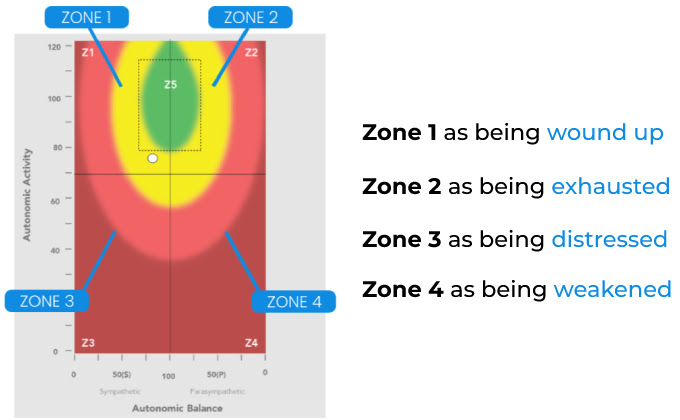The HRV, or Heart Rate Variability, test allows Dr. Diane to assess your stress load and, when combined with the Thermal and EMG scans, allows her to create a neurological profile for you. It gives her insight into your stress level and how that stress may be affecting your overall health.
The Thermal scan examines the impact that spinal stress is having on your organ and gland regulation, while the EMG scan tests “postural exhaustion” and give Dr. Diane a clear idea of how much energy is being wasted instead of being accessible for you to use.

ZONES AND WHAT THEY MEAN
Zone 1 in the upper LEFT quadrant describes the patient as being “wound up”. The patient is highly Sympathetic and also has a high amount of adaptive reserve (your ability to bounce back). Being highly Sympathetic means that the patient may have a stimulated heartbeat and high or rising blood pressure. This quadrant also indicates the patient (ability to lower heart rate and reduce blood pressure).
Zone 1 analogy – Sitting at a stop sign and revving your engine.
Zone 2 in the upper RIGHT quadrant is not frequently seen, as it shows a dominant Parasympathetic state but would be better described as an insufficiency in the Sympathetic response. These patients typically have a low adrenal function which contributes to muscle and bone weakness, high blood sugars, irritability or depression, and high blood pressure.
Zone 2 analogy – Trying to drive with the parking brake on.
Zone 3 is in the lower LEFT quadrant and the patient is described as distressed. When results of the HRV are in this quadrant, it means that their body is adapting poorly to stress and they exhibit lower vagal tone. They are in a state of parasympathetic dominance. Being in this state means they are living in a “fight or flight” state of stress and overwhelm. Hands and feet may feel cold, strong light irritates them, and they are unable to relax.
Zone 3 analogy – Driving with an empty tank and brakes that are failing.
Zone 4 is in the lower RIGHT quadrant and patients in this quadrant are described as being weakened. These patients have low parasympathetic responsiveness and very little reserve. This is concerning and needs to be addressed.
Zone 4 analogy – Trying to drive with brakes that have seized.
Zone 5 is the Green Zone and is considered the ideal target for remaining in a well-adjusted state. It IS very attainable to get and stay in the Green Zone for people under regular Chiropractic care.
Watch the video about Rainbow Graph Zones here: https://www.youtube.com/watch?v=Y6oDLsQkwTc
